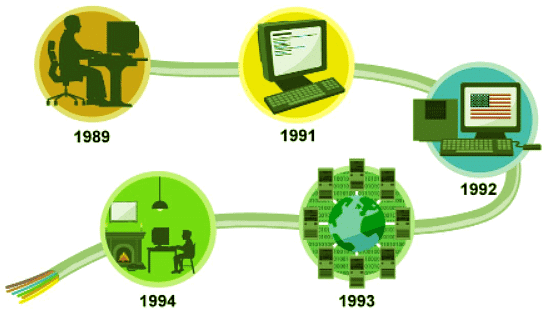What's next for the world wide web? | Year 6 Computing PDF Download
Overview of the World Wide Web

- The World Wide Web is a service accessible through the internet that facilitates the sharing of information among various devices.
- Developed in 1989 by Sir Tim Berners-Lee while working at CERN, Switzerland.
- Originated from the need to exchange data among different computers linked to the internet.
The history of the world wide web

The three protocols of the world wide web
Sir Tim Berners-Lee introduced three key protocols to facilitate seamless data exchange among all devices connected to the internet.
- URL (Uniform Resource Locator): Every webpage is assigned a unique address through URLs, enabling easy access and navigation.
- HTTP (Hypertext Transfer Protocol): This protocol governs the transmission of data between internet-connected devices, ensuring efficient communication.
- HTML (Hypertext Markup Language): HTML serves as the foundational language for creating webpages, allowing for the structuring and presentation of content.
The development of HTML
HTML was useful because it allowed people to add (markup) to the documents they had already created.
- The first version of HTML had only 16 commands because most webpages contained only text.
- Today, HTML (HTML 5) allows webpages to include various media such as video, sound files, images, and text.
- We can view webpages on a variety of devices. HTML can now detect the size of your screen and adjust the layout accordingly.
Personalised adverts on the web
- Have you ever searched for a product and then seen an advert for it on a webpage a few days later?
- This happens because search engines use your searches to select adverts they think will interest you.
- When different people view the same webpage on different devices, they may see different adverts.
- Many businesses use the web to promote their products, with webpages that you can visit to learn more about their offerings.
- These pages often have hyperlinks to online stores where you can buy their products and will also place adverts on other webpages.
Overview of the Internet of Things
- The Internet of Things (IoT) Defined: The Internet of Things refers to interconnected computing devices embedded in everyday objects that utilize the internet to send and receive data.
- Future Automation: In the upcoming years, the IoT is expected to become increasingly automated.
- Automated Tasks: Tasks will be executed without the need for human intervention.
- Example 1: Smart Fridges: Smart fridges will autonomously reorder food supplies when they are running low.
- Example 2: Wearable Smart Devices: Wearable smart devices will directly transmit collected data to your doctor for analysis when necessary.
- Example 3: Smart Speakers: Smart speakers will play your favorite music as you arrive home, without any manual input.
There are many predictions for how the World Wide Web might develop in the future. There is no guarantee that all these predictions will come true. But one thing is certain: the World Wide Web is here to stay.
Smart Home Devices Overview
- Doorbell Camera: A doorbell camera allows individuals to remotely check who is at their door using their smartphones, even when they are away from home. This enhances security and provides convenience.

- Smart Thermostat: Smart thermostats enable users to adjust their home's temperature from a distance, ensuring a comfortable environment upon their return. This feature helps in saving energy and optimizing comfort levels.

- Battery Monitoring: Devices with battery monitoring functionalities alert users when batteries require replacement. This proactive feature ensures that devices are always operational when needed.

|
19 videos|26 docs|3 tests
|
FAQs on What's next for the world wide web? - Year 6 Computing
| 1. What are some common examples of smart home devices? |  |
| 2. How do smart home devices connect to the internet? |  |
| 3. Can smart home devices be controlled remotely? |  |
| 4. Are smart home devices secure from hacking? |  |
| 5. How do smart home devices make our lives easier? |  |















